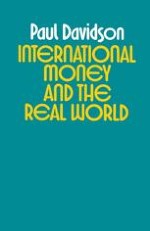1982 | OriginalPaper | Buchkapitel
Multinational Corporations and International Transactions
verfasst von : Paul Davidson
Erschienen in: International Money and the Real World
Verlag: Palgrave Macmillan UK
Enthalten in: Professional Book Archive
Aktivieren Sie unsere intelligente Suche, um passende Fachinhalte oder Patente zu finden.
Wählen Sie Textabschnitte aus um mit Künstlicher Intelligenz passenden Patente zu finden. powered by
Markieren Sie Textabschnitte, um KI-gestützt weitere passende Inhalte zu finden. powered by
Neoclassical models of international trade and monetary theory are typically constructed as if residents of one nation produced and sold goods and services to independent residents of another nation. Moreover, the economic agents in each nation engaging in production for foreign sales and in the actual conduct of foreign transactions are each conceived to be small and numerous, relative to the national governments and monetary authorities involved. Thus, neoclassical models assume ‘large economies’, i.e. economies with many (indeed perhaps a continuum) of agents in which all the ‘agents are without economic power’.1 This seemingly innocuous assumption of a world of multitudinous and small economic agents engaged in international trade (while the assumed number of governments are few) is necessary if rational agents are to treat prices parametrically (therefore permitting traditional General Equilibrium Theory to be applicable). In reality of course, such a conception of a legion of economic agents without economic power engaging in international trade has, at least, since Biblical Times, been demonstrably false. The trading companies of the early mercantilist and industrial eras, as well as present day multinational corporations (hereafter MNCs), have always had sufficient power to affect trading relations by their own actions. Hence neoclassical international trade and monetary theory analysis and its conclusions rest on a logical foundation which has no meaning for the real world. Such theories must be superseded by a more relevant and realistic logical analysis.
